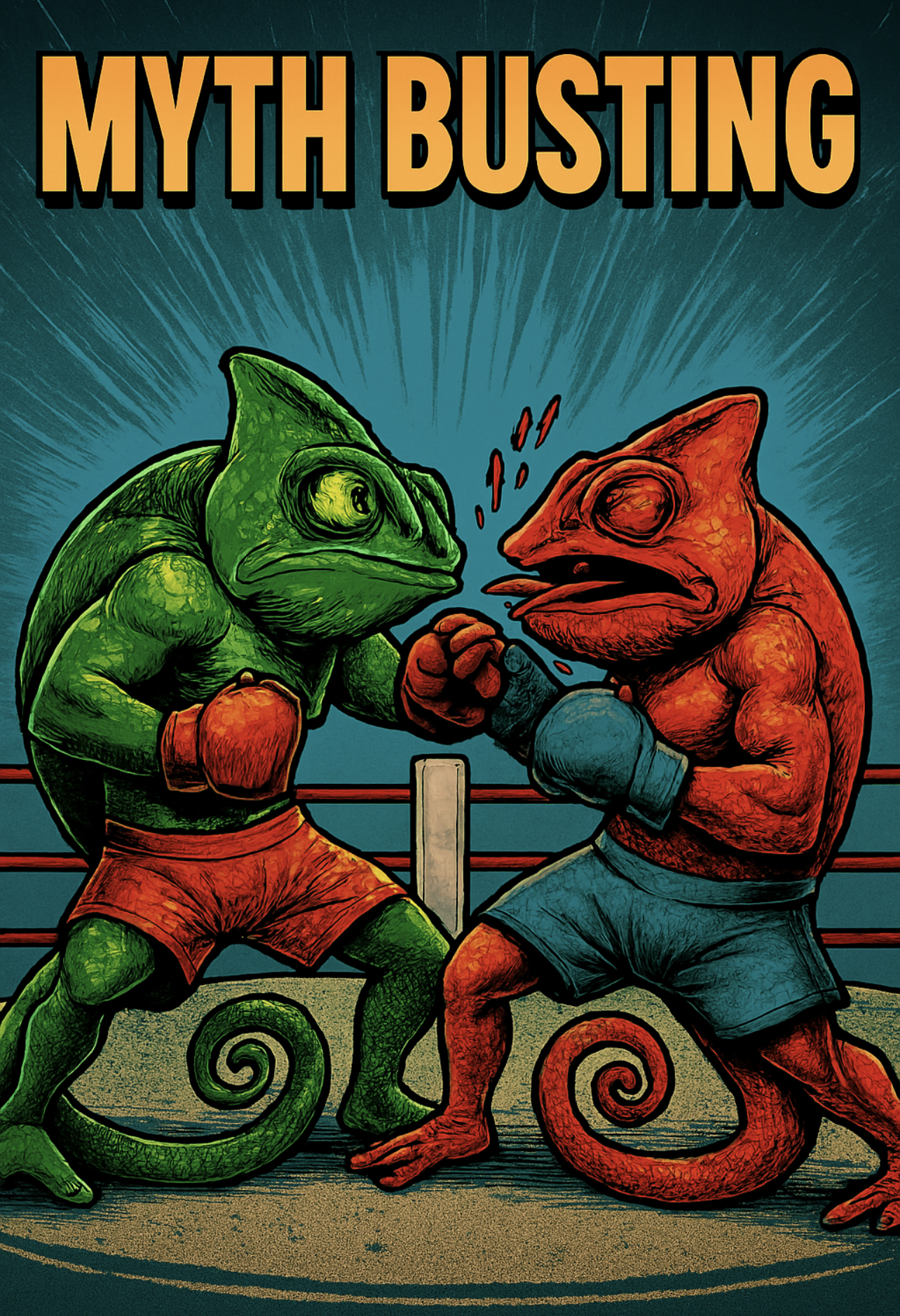54 Deadly Chameleon Myths Series
Despite decades of research, breeding trials, and a growing body of scholarly and popular publications, the digital landscape surrounding chameleon care is catastrophically polluted. Even with commendable efforts from a handful of high-quality Facebook groups and forums, the internet remains a chaotic swamp of misinformation, where fragments of truth are drowned in a flood of dangerous nonsense.

In recent years, the rise of AI-generated content has made things exponentially worse. These pages are typically commercial, designed to sell, not to educate, or authored by self-important amateurs with no competence to assess the quality of what AI spits out. And AI, with its shallow protocols and blind regurgitation, simply parrots the most frequently repeated garbage. The result? A vicious cycle of unreliable, misleading, and often lethal advice on the biology and husbandry of one of the most fragile reptile groups on Earth.
This mess creates a tragic illusion for newcomers. They believe they've done "research"—usually a few Google searches or a quick chat with AI—and then act on the garbage they find. When they finally stumble into competent communities with sick animals and broken setups, the disillusionment is brutal. Some feel offended by correction. Others ignore expert advice, trusting AI hallucinations over hard-earned expertise. Many underestimate the importance of details. And the consequence? A silent cry from chameleons in captivity, a suffering so profound it could shake the heavens.
So I've decided to write a series of short, sharp articles. Each one will dissect a myth: precisely, unapologetically, and with the forensic clarity these animals deserve. This is not just about setting the record straight. It's about restoring awe, demanding rigor, and honoring the lives of creatures too often sacrificed to human laziness.
Here are the list of myths already addressed. More will follow.
Myth 54: "True Blue Nosy Be Is a Breed or Breeding Line"
Myth 53: "Chameleons Need Exercise As Enrichment"
Myth 52: "Sunken Eyes Are a Reliable Sign of Dehydration"
Myth 51: "Who Is Saying Constructive Criticism Is a Hater"
Myth 50: "The Background Of The Cage Should Be Dark"
Myth 49: "All Females Need a Laybin Permanently"
Myth 48: "Chameleons Do Not Overhydrate"
Myth 47: "Sperm Plug is Present in Chameleons"
Myth 46: "Chameleons Should Drink From a Bowl"
Myth 45: "The Chameleon Cage Needs to Be Misted Several Times a Day"
Myth 44: "Supplements Are Never Enough, Never Too Much"
Myth 43: "Water Must Be Provided Without Limitations"
Myth 42: "Free Roaming Is Best Way How To Keep Chameleons"
Myth 41: "The Mesh Cages Must Be Wrapped in Foil To Raise Humidity"
Myth 40: "Chameleons Eat Plants For Nutrition And For Hydration"
Myth 39: "The Temperature I Measure With Temp-Gun at the Basking Branch Is the Basking Temperature"
Myth 38: "The Temperatures and Humidities Should Be Kept Same All Year Around"
Myth 37: "The Walls Of a Cage Are Good To Be Covered By Bark Or Any Other Material"
Myth 36: "I'm Not Good at Keeping Plants Alive, But My Chameleon Is in Great Shape"
Myth 35: "I need to buy everything, branches, fixtures, special tools to place branches in the cage"
Myth 34: "Jackson's Chameleons Captive Parameters Are Just Same as Other Chameleons"
Myth 33: "Chameleons Need a Basking Bulb or Ceramic Heater at Night"
Myth 32: "Chameleons Need All Lights 12 Hours a Day"
Myth 31: "Chameleons need it hot."
Myth 30: "Golden Rule: Any Empty Space is Unusabe Space"
Myth 29: "Big-leaf plants are great for chameleon enclosures"
Myth 28: "It's a Good Idea to Hang Many Plant Pots in a Chameleon Cage"
Myth 27: "Plastic Plants Are a Good Alternative for Chameleons"
Myth 26: "Chameleons Should Eat Every Day They Shouldn't Starve"
Myth 25: "An Expert Can Tell How Old a Chameleon Is"
Myth 24: "How Much You Feed Depends on the Age of Your Chameleon"
Myth 23: "Gutload Feeders with Veggies -It's Good for Chameleons!"
Myth 22: "Chameleons Love Ropes"
Myth 21: "Completely White rate Is Good"
Myth 20: "Protruded Eyes Are a Reliable Sign of Ophthalmic Disease"
Myth 19: "Best Advice I Get from Keepers Like Me in FB Groups and Forums"
Myth 18: "The chameleon knocks on the door and wants to socialize with me"
Myth 17: "The chameleon cage must be beautiful"
Myth 16: "The white crystals around the nostrils are a sign of calcium overdose or too many minerals in drinking water"
Myth 15: "Warm Water Soaking and Shower Helps Chameleons"
Myth 14: "Chameleons Are Cheap, Which Is Good for Herpetoculture"
Myth 13: "Animals in Captivity Always Live Longer Than in the Wild"
Myth 12: "The droplets produced by foggers are much bigger than in natural fog and do not work the same as in the wild"
Myth 11: "Chameleons Are Aggressive-They Bite!"
Myth 10: "Chameleons Don't Need to Fear Us- We're the Good Guys!"
Myth 9: "Let the Chameleon Decide" - A Fatal Error in the Matrix
Myth 8: "BSFL Is a Panacea"
Myth 7: "Bee Pollen Is Nonsense" - A Forensic Alarm Bell
Myth 6: "We Can Outsmart Mother Nature"
Myth 5: "Females Lay Eggs Like Chickens No Matter What"
Myth 4: "Light Sprinkling" with Calcium Powder"
Myth 3: "The Roach Loop: How Profit Logic Poisons Chameleons"
Myth 2: "GO VET: The Blank Advice That Fails Chameleons"
Myth 1: "Chameleons Need Cages That Are Taller Than They Are Wide"
Each myth is being dismantled with evidence, precision, and respect for the animals, and for the truth.\
you will find the full series step by step published at www.chameleons.info